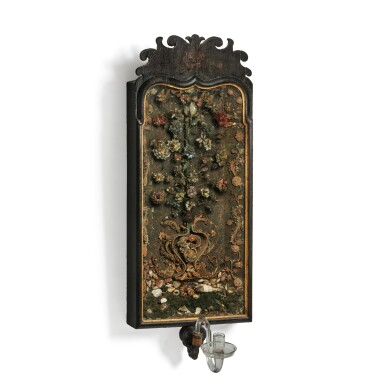The Kindig Collection: Important American Furniture, Paintings, Silver & Decorative Arts
The Kindig Collection: Important American Furniture, Paintings, Silver & Decorative Arts

Very Fine and Rare William and Mary Quillwork Wall Sconce, Boston, Massachusetts, Circa 1740
Auction Closed
January 22, 09:24 PM GMT
Estimate
50,000 - 80,000 USD
Lot Details
Description
Very Fine and Rare William and Mary Quillwork Wall Sconce
Boston, Massachusetts
Circa 1740
Appears to retain its original surface and glass sconce arm.
Height 30 1/2 in. by Width 11 3/4 in. by Depth 3 in.
This remarkable sconce is one of only approximately twenty five that survive today. It was likely made in Boston in the early to mid 18th century. This elaborate sconce is made of quillwork (or filigree work) composed of rolled or twisted colored papers pasted to a wooden backing and arranged in varying designs that often utilized metal, wire, beads, feathers, shells, waxwork, silk threads, and also mica flakes to make the composition sparkle when seen by candlelight. Sconces of this type were glazed and mounted within shadow-box frames, and many were fitted with a wooden socket at the base to support a silver candle arm for illumination at night.
This sconce relates directly to an example sold at Brunk Auctions, Property from the Collection of Dudley and Constance Godfrey, December 5, 2020, lot 582. Another related example sold at Sotheby’s, Property from the Collection of Irvin & Anita Schorsch: Hidden Glenn Farms, January 20-22, 2016, lot 599. For other similar examples, see a pair of sconces made by Eunice Deering of Kittery, Maine in the collection of The Metropolitan Museum of Art (acc. 48.158.12 and .13) and one possibly made by Ann (Odiorne) Ringe of Portsmouth, New Hampshire in the collection of Historic New England (acc. no. 1991.270) (see Nina Fletcher Little: Little by Little: Six Decades of Collecting American Decorative Arts (New York: E.P. Dutton, 1984), p. 28, fig. 36). Four others include one at Colonial Williamsburg (acc. no. 1961.84) (see Edith Gaines, “Collectors Notes,” The Magazine Antiques (October 1962): p. 411), a pair in the collection of the Wooster Art Museum (acc. nos. 1938.75 and 1938.76); and one owned by Mrs. W. G. Wendell (see Edith Gaines, “Collectors Notes,” The Magazine Antiques (February 1970): p. 272).
